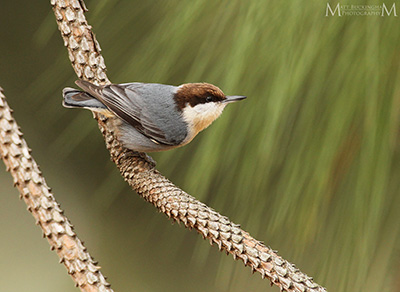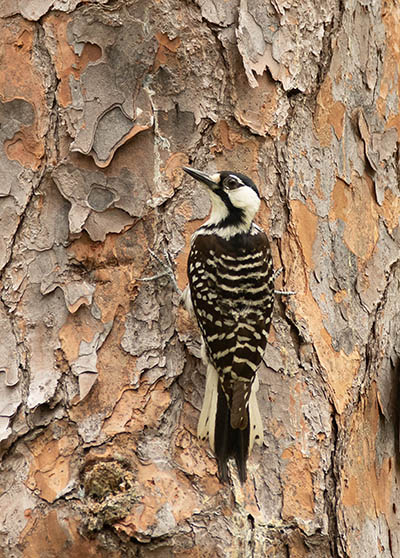Rare Bird Species of Open Longleaf Forests, Woodlands, and Savannas
Red-cockaded Woodpeckers, Bachman’s Sparrows, and Brown-headed Nuthatches are considered rare and notable bird species of the southern pines. The presence of these birds is a sign of a healthy longleaf pine ecosystem.
Red-cockaded Woodpecker (Picoides borealis)
Perhaps the most talked about bird associated with longleaf pine is the federally endangered Red-cockaded Woodpecker (RCW). While there are several species of woodpeckers that use pine forests, the RCW requires a narrow range of living conditions to thrive.
The RCW is the only woodpecker species in the world to make a nest cavity in a living tree! Large longleaf pine trees can develop red heart rot, a fungus that softens the pine’s heartwood. Trees can still live with this condition, but it allows the woodpecker to excavate a nesting cavity and to drill holes for the resin, or pitch, which drains from the tree. That sticky sap serves as a great deterrent for snakes that prey on young in the nest.
RCWs live in family groups known as clusters, with young males dispersing in the spring to establish new colonies. Pine forests with open savanna grassy conditions and widely spaced trees are favorite habitat conditions.
Bachman’s Sparrow (Aimophila aestivalis)
Secretive and harder to observe, the Bachman’s Sparrow prefers the lower shrub layer of the forest. Open conditions provide a combination of vegetation cover and sources of insects for this state threatened bird. If a site becomes too thick with hardwood shrubs, the Bachman’s Sparrow will abandon the site and move to find more optimal habitat.
Brown-Headed Nuthatch (Sitta pusila)
 Brown-Headed NuthatchMatt Buckingham – A Naturalist’s Journey, Flickr, and Instagram
Brown-Headed NuthatchMatt Buckingham – A Naturalist’s Journey, Flickr, and InstagramThis petite bird is known for its zig-zag pattern of movement as it works its way down a tree. Traveling upside down on the tree bark, the nuthatch uses its chiseled beak to consume insects. Brown-headed Nuthatches are endemic year-round residents of mature, open pine habitats from east Texas to southeast Virginia. The greatest abundance occurs in stands with large snags, an open mid-story, open canopy, and sparse understory maintained by fire or silvicultural thinning.


